| Back to Back Issues Page |
 |
|
Bangkok Travelbug May 2017 A Dedication to my Parents May 03, 2017 |
| Hello
The early days My father, Lim Cheng Hai was born in Singapore on 1 August 1915. My mother, Wong Quee Chin was born in Ipoh, a tin mining town in Perak, Malaya, (West Malaysia today) on 10 April 1921. Her parents must have moved south to Singapore shortly after her birth as she was baptised in Saint Andrew’s Cathedral, Singapore later that year. Thirty years later I was baptised in the same church. I never got to see my maternal grandparents as my mother was orphaned at a very young age. She spent most of her time a convent where she got her education. In 1939, when my mother completed her education at the age 18, she joined the nursing service in Singapore. That year was ominous; Nazi Germany had invaded Poland starting World War II in Europe, the Japanese invasion of China was into its second year. The dark clouds would soon reach South-East Asia. 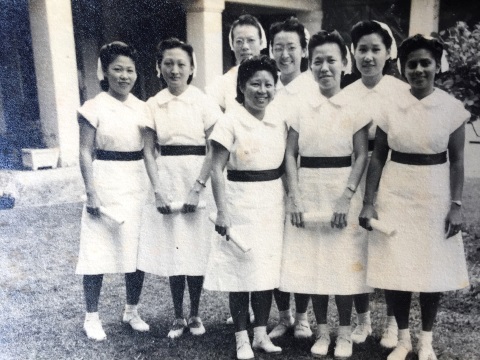
The early days, my mother (back row second from left) and Aunty Kiew (front row second from left) later to be my Godmother Around this time, my father volunteered for the Civil Defence and trained to be an Air Raid Precaution (ARP) warden. (More of their war-time experiences in the next section) My parents met after the war through their love for ball-room dancing. They were married on 22 April 1950 in Saint Andrew’s Cathedral. 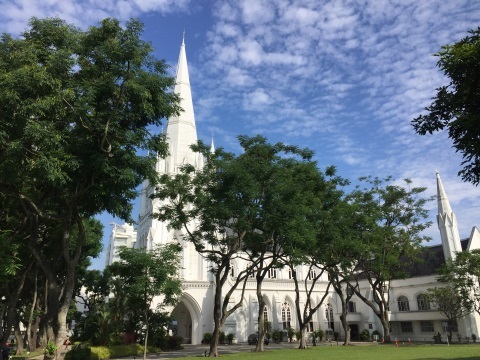
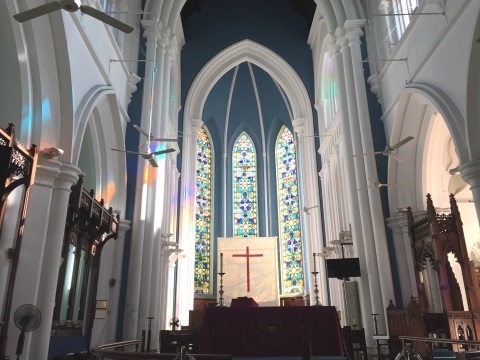
Saint Andrew’s Cathedral, Singapore 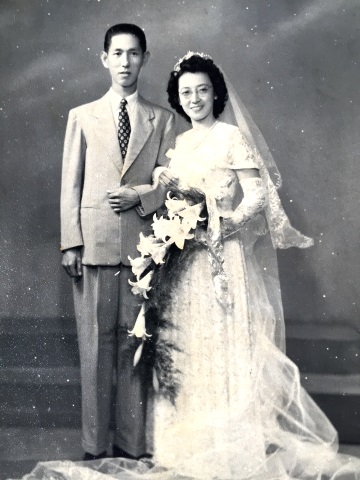
My parents on their wedding day – 22 April 1950 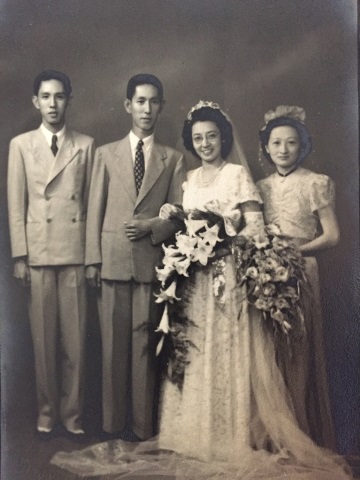
The best man was my father’s second brother, Uncle Cheng Huat, the bridesmaid was my mother’s colleague, Aunty Kiew and soon to be my Godmother 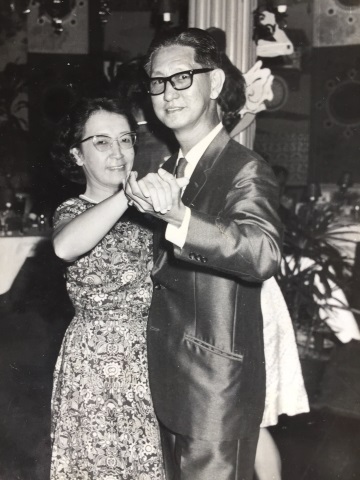
Dancing into the night After the war, my mother continued to work as a nurse and in the 1960s worked in Ward 7, the Accidents and Emergency Ward of the Singapore General Hospital. She wasn’t spared the sight of blood even in peace. 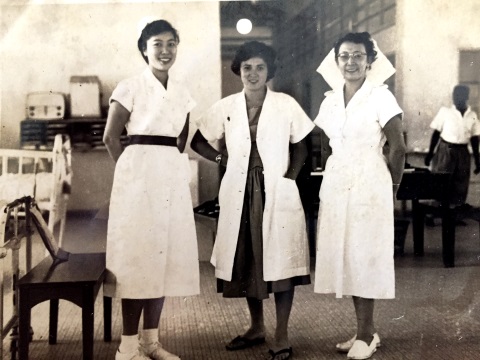
My mother (right) in the head dress of a nursing sister On 12 July 1963, prisoners in the penal colony of Pulau Senang¹, ran riot, killed the British superintendent and two local assistants, attacked prison staff with knives and bottles, ran rampage, burned and destroyed the prison facilities. ¹Pulau Senang is an island about 11 km south of Singapore and ironically named Isle of Ease in Malay. On 29 October 1965 after a long trial of 65 days, 18 of the inmates were found guilty of murder and were hung. The injured were flown back to Singapore to the emergency ward. My mother returned from work that evening with her usually white neatly pressed and starched uniform splattered with blood! She didn’t even bat an eyelid, it was all in a day’s work. This happened often during her duties and I just got used to the sight of blood. As a reward for her earlier hard postings, her final posting, just prior to retirement, was to the Saint Andrew’s Orthopaedic Hospital, a small hospital for paraplegic children off Upper East Coast Road. It was pleasant posting, the hospital was by the beach, in cool and spacious grounds shaded by tall trees. What’s more we were accommodated in a spacious three-bedroom bungalow! 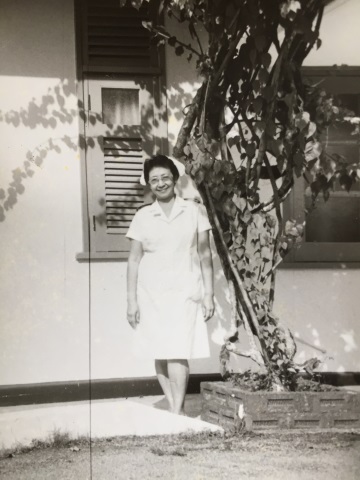
Mother outside our family quarters in the Saint Andrew’s Orthopaedic Hospital In the hospital, every child’s birthday was celebrated along with the major festivals in Singapore! There were many visits by volunteer groups to organise parties and cheer the children up. 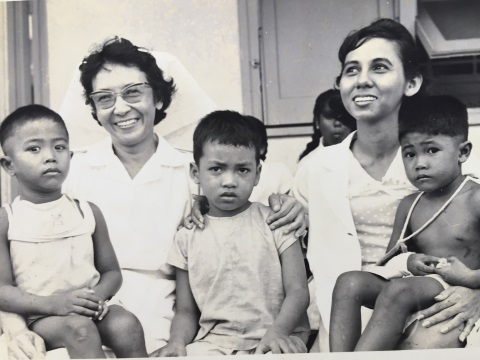
My mother (left) and Dr Stefanie Pereira (right), medical officer for the hospital and some of the children under their charge Contents War-time memories During World War II, the people in Singapore endured three and a half long, hard years of Japanese occupation from 15 February 1942 – 12 September 1945. When I was young my parents related two separate incidents they experienced during the war that were seared in my memory. The first incident was related by my father about his experience as an air raid warden. When the Japanese occupied Singapore, they called up all the Chinese males for the dreaded Sook Ching² registration. My grandmother begged him not to go but my father said that if he didn’t go, sooner or later he will be caught. There were Japanese check points all over the city. My father’s job as an air raid warden probably saved him. ²Sook Ching or purge through cleansing (Chinese) or purging of Overseas Chinese (Japanese) was a systematic Japanese operation to rid their occupied territories of Chinese who supported China during the Japanese invasion or those engaged in anti-Japanese activities. Those who passed the registration were given an ink stamped on their arms, those who failed were taken away to be shot outside the city. Sook Ching registration and execution sites are marked in Singapore to serve as a grim reminder of these terrible atrocities. The air raid wardens were assigned to their neighbourhoods for familiarity with the local community. Their responsibilities were to organise the people to dig improvised air-raid shelters, fill up sand bags to build protective walls and get everybody into the shelters when there was an air raid alert. Buildings in Singapore in those days had no basements. My father’s family home was in Tanjong Pagar in Southern Singapore. The Tanjong Pagar terminal railway station and Keppel Harbour were in the vicinity; both were prime military targets. Fortunately, most of the bombs fell on the Naval Base to the north, though the Empire Dock in Keppel Harbour suffered some damage. So, my father had the experience of being bombed by both sides; first by the Japanese during their offensive on 1941 - 42 and again in 1943 – 1945 by the Allies³! ³From November 1944 – March 1945, Boeing B-29’s (Super Fortresses) from the XX Bomber Command, United States Army Air Force (USAAF) based in Kharagpur, (near Calcutta) West Bengal, North-East India carried out raids on Japanese occupied Singapore. They targeted the Naval Base to the north, Keppel Harbour and the oil storage on the off-shore islands to the south. Though little damage was done, this was a sign that the tide had turned. My mother had a totally different experience just before the fall the Singapore in 1942. As a junior nurse in the Singapore General Hospital, she was assisting a British surgeon in an operation on a pregnant Chinese woman badly injured by bomb shrapnel. By then the electricity and water supply were erratic. The surgeon had to amputate both arms and legs of the poor woman; she didn’t survive the operation, neither did her child. It was perhaps a merciful way out. Imagine struggling through three and a half years of near starvation conditions without arms and legs and with a newly born baby. Contents Remembering my parents After my mother’s funeral, I went through the things in her wardrobe, and found a treasure trove of family photographs, in albums and in boxes. The old photos used here are from that collection. My parents have photographed almost every stage of their lives, before marriage, after marriage and the stages of my growing up. My photos were taken every three months, every birthday of mine as a boy was celebrated and photographed. 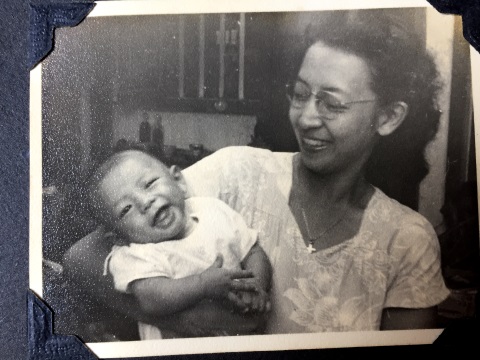
Three months old 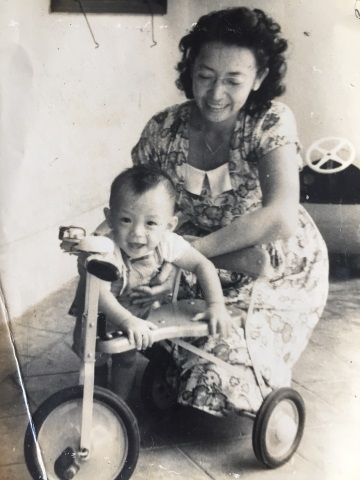
Nine months old 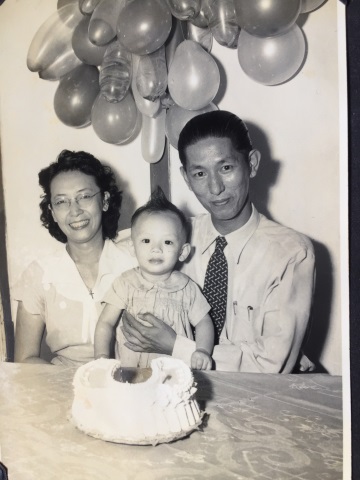
One year old – my first birthday party I loved horses as a result of reading cowboy comics, like the Lone Ranger. Every year my father took me to the Civil Defence Annual Fair for a pony ride. My feet couldn’t even reach the stirrups. 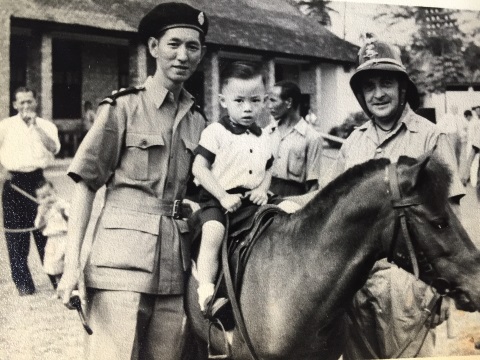
Pony ride at the Civil Defence Annual Fair I love dogs, father got me my first dog even though mother disliked dogs. 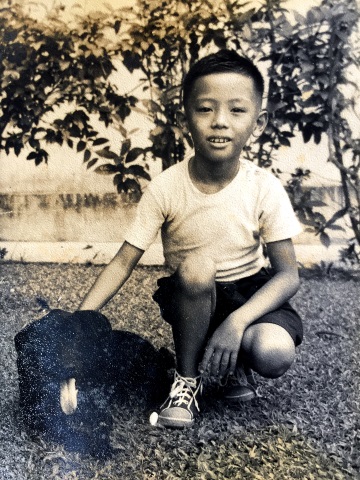
My first dog When I graduated from the local university in Singapore at 21, I had dinner with my parents. After dinner, father took me aside and said, "Son, we have done our duty to you. We have given you the best education we could afford to give. From now on you are on your own". I was too stunned to remember what I said in reply. In later years, I began to appreciate the significance of those words. My parents were preparing me for life. Going through the drawers in my father’s old desk uncovered even more surprises, I found these two items which I will always treasure. The first item looked like a military medal totally unfamiliar to me. On one side of the medal was a bust of King George VI, King of the United Kingdom from 1937 to 1952. On the other side were the words, "1939 – 1945 The Defence Medal". 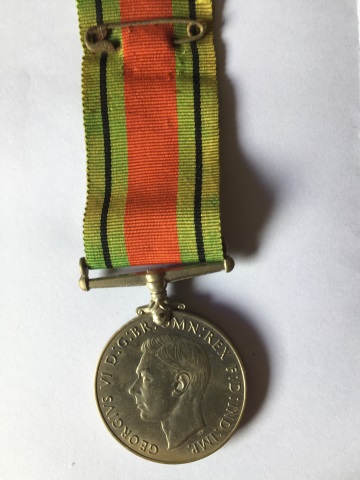
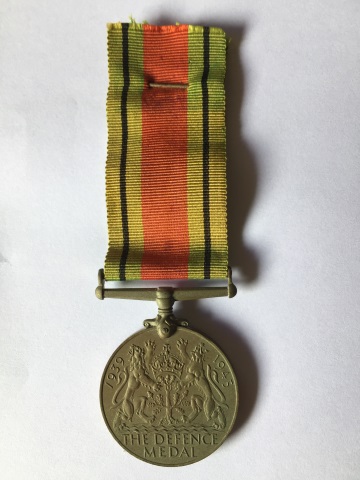
Medal from the King Only then did I realize that this medal was presented to my father for his war-time services as an air raid warden. The second item was an old card made from brown paper. Post World War II Britain was still under strict rationing for some items. These words were printed on the cover, "To the Nurses of Singapore 1942 - 1945". The card also had a tab with my mother’s name printed on it 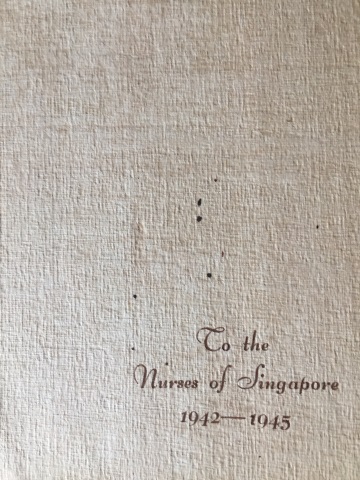
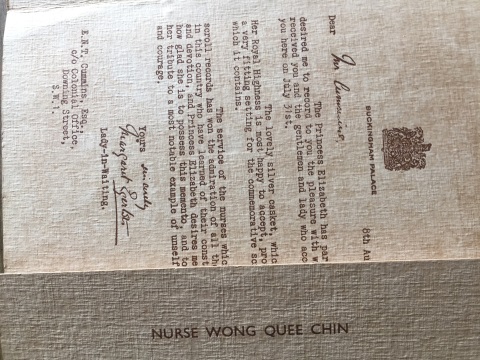
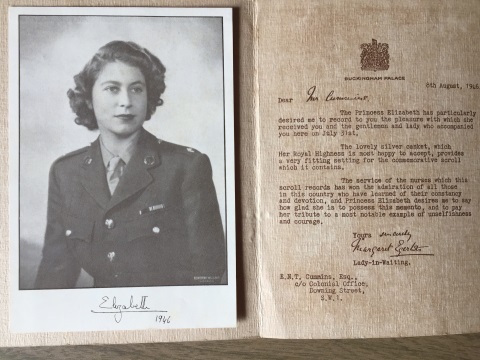
Card from the Princess Inside the card was a photograph of Princess Elizabeth in the uniform of an honorary second subaltern in the Women’s Auxiliary Territorial Service where she trained as a driver and mechanic in 1945. The message in the card dated 8 August 1946 was from the Lady-in-Waiting to the Princess to the Colonial Secretary. "The Princess Elizabeth has particularly desired me to record to you the pleasure with which she received you and the gentleman and lady who accompanied you here on July 31. The lovely silver casket, which the Royal Highness is most happy to accept, provides a very fitting setting for the commemorative scroll which it contains. The service of the nurses which this scroll records has won the admiration of all those in this country who have learned of their constancy and devotion, and the Princess desires me to say how glad she is to possess this memento, and to pay her tribute to the most notable example of unselfishness and courage." My parents must have treasured these two articles, they kept them to their dying days. I will always remember my parents for the values that they have instilled in me, honesty, integrity, doing the right thing and standing up for what is right. Rest in peace, Pa, Mum, you are now happy together in a better place free from pain, suffering and worry. Thank you for everything that you have done for me. Thank you for preparing me for life. Now I lay me down to sleep, I pray the Lord my soul to keep. If should die before I wake, I pray the Lord my soul to take. A child’s bedtime prayer by Joseph Addison – 1711 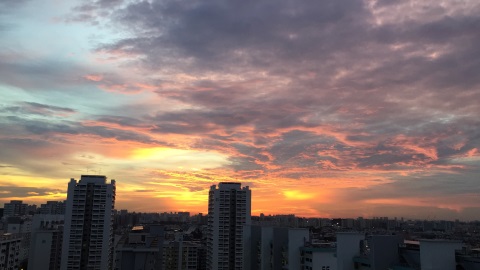
Sunset over Marine Terrace – view from the balcony of our family apartment Contents Next month We return to Thailand to visit the ancient kilns on the River Noi, Singburi If you enjoyed reading this e-zine, please forward it to a friend. If you received this from a friend and found it interesting, please subscribe at Bangkok Travelbug. What do you think of the Bangkok Travelbug? We love to hear from you What other subscribers have said Till next month then. Eric Lim Tour Bangkok Legacies Find us on Facebook If you are an independent traveller, here's a handy e-guide book, Tour Bangkok Legacies, which will help you along as you explore the streets of Bangkok and discover its old treasures. It's complete with historical descriptions, maps and detailed directions on how to get to these places. My Kindle e-book 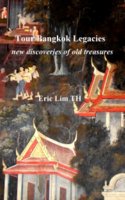
Copyright@2008-2017 Tour Bangkok Legacies All rights reserved |
| Back to Back Issues Page |